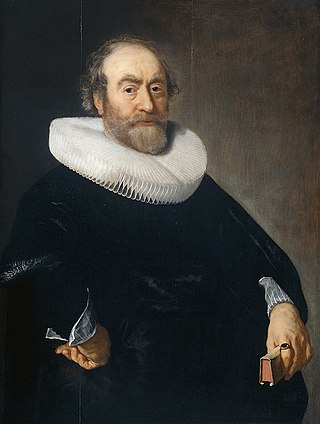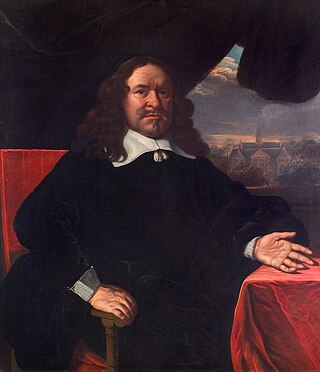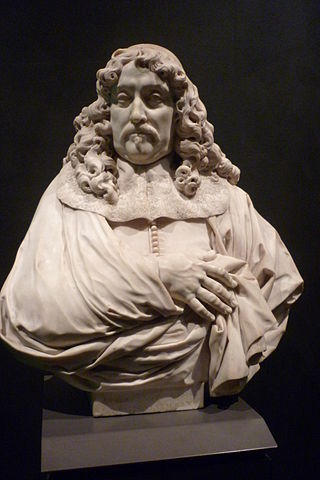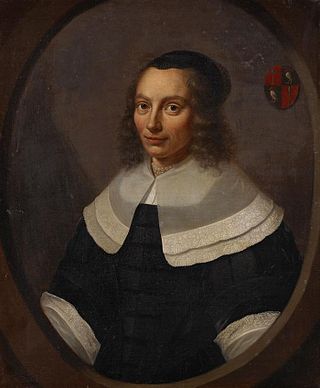
Willem Schrijver (Leiden, 1608 - Amsterdam, October 17, 1661) was a Dutch patrician and politician of the Dutch Golden Age.

Willem Schrijver (Leiden, 1608 - Amsterdam, October 17, 1661) was a Dutch patrician and politician of the Dutch Golden Age.
Willem was born in the city of Leiden, the son of the important philologist Pieter Hendricksz Schrijver, aka Petrus Scriverius, and his wife Anna van der Aar. [1] Willem grew up in Amsterdam and held various positions in the city, becoming a lieutenant in the citizen guard in 1651 and a captain in 1653. In 1655 he became commissioner of the city of Amsterdam, [2] and between 1656 and the year of his death in 1661 he was part of the Vroedschap. Between 1658 and also 1661 he was a councilor to the Admiraliteit van West-Friesland en het Noorderkwartier . [1]
In 1645 Willem married the extremely wealthy patrician daughter Wendela de Graeff, daughter of burgomaster Jacob Dircksz de Graeff and Aaltje Boelens Loen and widow of Pieter van Papenbroek. [1] Due to this marriage he became a brother-in-law to statesman and Amsterdam burgomaster Cornelis de Graeff and uncle by marriage of Grand pensionary Johan de Witt. The couple had the son Willem Schrijver II (1651-1673), who married Margaretha Six (1653-1704). [1] He was ranked 57 at the richest people of the Golden Age with a sum of 580,000 guilders. [3] The family of Willem and Wendela lived in a town house on the Herengracht.
In 1655/56 Willem commissioned Rembrandt the painting Jacob Blessing the Sons of Joseph, which depicts his father Petrus, himself (as Joseph) with his wife Wendela and their two sons from her first and second marriage as biblical characters. [4] Around 1660, Willem was also painted at The Arrival of Cornelis de Graeff and Members of His Family at Soestdijk, His Country Estate by Thomas de Keyser and Jacob van Ruisdael. Alongside his brothers-in-law Pieter Trip and Andries de Graeff, he is the first of the three figures standing on the roadside to the right of center. [5]

Johan de Witt, lord of Zuid- en Noord-Linschoten, Snelrewaard, Hekendorp en IJsselvere, was a Dutch statesman and a major political figure in the Dutch Republic in the mid-17th century, the First Stadtholderless Period, when its flourishing sea trade in a period of global colonisation made the republic a leading European trading and seafaring power – now commonly referred to as the Dutch Golden Age. De Witt was elected Grand pensionary of Holland, and together with his uncle Cornelis de Graeff, he controlled the Dutch political system from around 1650 until the Rampjaar 1672. This progressive cooperation between the two statesmen, and the consequent support of Amsterdam under the rule of De Graeff, was an important political axis that organized the political system within the republic.

Frans Banninck Cocq, free lord of Purmerland and Ilpendam (1605–1655) was a knight, burgemeester (mayor) and military person of Amsterdam in the mid-17th century, the Dutch Golden Age. He belonged to the wealthy and powerful Dutch patriciate, the regenten, and is best known as the central figure in Rembrandt's masterpiece The Night Watch.

Cornelis de Graeff, often named Polsbroek or de heer van (lord) Polsbroek during his lifetime was an influential regent and burgomaster (mayor) of Amsterdam, statesman and diplomat of Holland and the Republic of the United Netherlands at the height of the Dutch Golden Age.

Catharina Pietersdr Hooft was a woman of the Dutch Golden Age. She became famous at a very early age, when she was painted by Frans Hals.

Andries Bicker, lord of Engelenburg was a powerful Amsterdam burgomaster and Dutch politician and diplomat during the Dutch Golden Age. He was a prominent member of the Bicker family of Amsterdam regents who, together with the related De Graeff family, governed the city of Amsterdam and with it the province of Holland for about half a century and, at that time, effectively the Republic of the Netherlands when it was at the height of its power.

Joan or Johan Huydecoper van Maarsseveen, knighted lord of Maarsseveen, was an important merchant, financial expert, property developer active in Amsterdam and a director of the Dutch East India Company during the Dutch Golden Age. The republican minded Huydecoper was an influential member of the Dutch States Party, diplomat and six times mayor of Amsterdam. He was together with Cornelis de Graeff one of the initiators of the construction of the new town hall of Amsterdam and was a prominent patron of the arts and art collector. Beside Maarsseveen he held the feudal titles of Neerdijk, Thamen and Blockland. Huydecoper is representative of the love of art, political influence and welfare in the Golden Age.

De Graeff is an old Dutch patrician and noble family,

Andries de Graeff was a regent and burgomaster (mayor) of Amsterdam and leading Dutch statesman during the Golden Age.

Pieter de Graeff, was a Dutch aristocrat of the Dutch Golden Age and one of the most influential pro-state, republican Amsterdam Regents during the late 1660s and the early 1670s before the Rampjaar 1672. As president-bewindhebber of the Dutch East India Company, he was one of the most important representatives and leaders of the same after the Rampjaar.

Johan de Graeff, also Jan de Graeff - patrician of Amsterdam, Free Lord of Zuid-Polsbroek - was a member of the De Graeff - family from the Dutch Golden Age. His political Position was that of the Dutch States Party.

Jan Gerritsz. Bicker (1591–1653) was a merchant, mayor (burgomaster) and a member of the Bicker family, an influential patrician family of regenten from Amsterdam.

Jacob Dircksz de Graeff, free lord of Zuid-Polsbroek was an illustrious member of the Dutch patrician De Graeff family. He belonged to States Faction and was an influential Amsterdam regent and burgomaster (mayor) of the Dutch Golden Age.

Jacob de Graeff was a member of the De Graeff-family from the Dutch Golden Age. He was an Amsterdam regent and held the title as 20th Free Lord of Ilpendam and Purmerland.

Maria Overlander van Purmerland was a noble from the Dutch Golden Age and Free Lady of Purmerland and Ilpendam. She was married to Frans Banninck Cocq captain of Rembrandts painting The Night Watch.

Agneta de Graeff van Polsbroek, was a patrician woman from the Dutch Golden Age. She became known as the mother-in-law of Johan de Witt.

Cornelis Bicker van Swieten, heer (lord) van Swieten, was an Amsterdam regent of the Dutch Republic during the Golden Age and a governor of the Dutch West India Company. He was also a sugar merchant, hoogheemraad of the Hoogheemraadschap van Rijnland and a counsellor of the States of Holland and West Friesland for Amsterdam at The Hague. He belonged to the Dutch States Party and was in opposition to the House of Orange.

Gerrit Pieter Bicker (1554–1604) was a Dutch merchant, patrician, and one of the founders of the Compagnie van Verre and its successor the Dutch East India Company.

Gerard Bicker (I) van Swieten, Lord of Swieten was a Dutch aristocrat and civil servant.

Jean Deutz was a Dutch merchant, banker and financier of his brother-in-law Grand pensionary Johan de Witt.

Wendela de Graeff, also called Wijntje de Graeff was a patrician of the Dutch Golden Age.